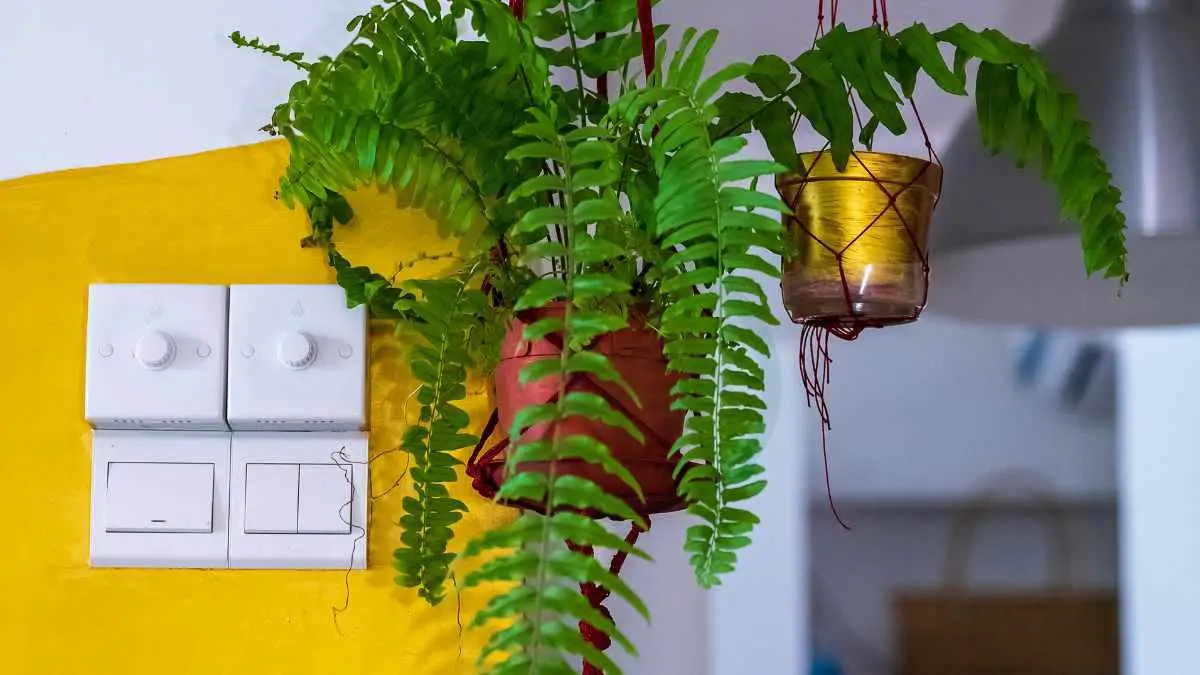Wondering, "How much sunlight do Boston ferns need?" Not to worry, I've got you covered. Understanding the light requirements of your Boston fern is essential for its health and thriving growth.
Boston ferns, known scientifically as Nephrolepis exaltata 'Bostoniensis,' are native to tropical regions and prefer indirect sunlight or partial shade. They thrive in bright, filtered light, making them ideal for placement near a north or east-facing window where they can receive gentle morning sun rays. However, they can tolerate low light conditions as well, making them versatile indoor plants. It's crucial to avoid direct sunlight, as it can scorch their delicate fronds in a spot. With the right amount of light, your Boston fern will flourish, adding lush greenery to your indoor space.
Ready to learn more about caring for your Boston fern? From watering tips to soil requirements, there's plenty more to discover to ensure your fern thrives in its environment. Let's dive deeper into creating the perfect conditions for your beloved plant.
Key Takeaways
- Understand the light needs of Boston ferns to provide optimal care.
- Place Boston ferns in bright, indirect light for healthy growth.
- Adjust light conditions by moving the fern if it shows signs of stress.
- Choose suitable Boston fern varieties based on available light in your space.
- Prune Boston ferns regularly to maintain their shape and health.
- Propagate Boston ferns through division for new plant growth.
Understanding Boston Ferns
Light Requirements
Boston ferns thrive in bright, filtered light daily, ensuring optimal growth. Direct sunlight should be avoided to prevent foliage burning. A minimum of a couple of hours of indirect light is essential for their development.
When caring for Boston ferns, it's crucial to place them in an environment with the right light conditions. Ensuring they receive adequate bright, filtered light helps in their growth process. Avoiding direct sunlight protects the foliage from damage.
Ideal Soil Conditions
For ideal growth, Boston ferns require well-draining soil to prevent waterlogging issues. Using a combination of peat moss and perlite creates optimal soil conditions for these plants. Maintaining slightly acidic soil pH levels contributes to the overall health of Boston ferns.
To maintain healthy Boston ferns, it's important to provide them with well-draining soil. This prevents waterlogging and ensures proper root health. Using a mix of peat moss and perlite creates ideal soil conditions for these plants.
Watering Needs
Regular watering is essential to keep Boston ferns' soil moist but not soggy. Allowing the top inch of soil to dry out before watering again promotes healthy root growth. Using room temperature water helps in avoiding shock to the roots.
To ensure the health of your Boston ferns, consistent and proper watering is key. Keeping the soil moist but not wet supports their growth. Allowing the top layer of soil to dry out before watering again prevents over-watering.
Choosing Fertilizers
Selecting a balanced liquid fertilizer is recommended for feeding Boston ferns adequately. Applying fertilizer sparingly during the growing season helps maintain their health and vitality. Over-fertilizing should be avoided as it can lead to damage to the ferns.
When choosing fertilizers for your Boston ferns, opt for a balanced liquid option that provides essential nutrients. Applying fertilizer sparingly during the growing season ensures optimal nutrition without causing harm to the plants.
Optimal Light Exposure
Daily Sunlight Needs
Boston ferns thrive with cool morning sun to support their growth and health. Placing them in dappled shade outdoors or near a bright window indoors is ideal. To prevent damage, it's crucial to avoid excessive direct sunlight exposure.
Signs of Inadequate Light
Yellowing Leaves
- Overwatering may be the cause if Boston fern leaves begin to turn yellow.
- Promote new growth by trimming off yellow leaves carefully.
- Adjust the watering schedule to prevent further yellowing issues.
Slow Growth
- If your Boston fern shows slow growth, consider increasing humidity levels.
- Providing adequate light is essential for stimulating healthy growth.
- Check for any pests that might be impeding the plant's development.
Symptoms of Excess Sunlight
Scorched Fronds
- Encourage new growth by trimming off scorched fronds gently.
- Relocate Boston ferns to a shadier spot to avoid additional scorching.
- Regularly monitor their sunlight exposure to prevent future damage.
Dry, Brittle Leaves
- Prevent leaves from drying out by increasing the humidity levels around the plant.
- Maintain moisture by lightly misting the Boston fern leaves on a regular basis.
- Proper watering practices are essential to ensure the leaves remain hydrated.
Adjusting Light Conditions
Relocating Ferns
- Gradually acclimate Boston ferns to a new location to prevent shock.
- Choose a spot with suitable light conditions for relocation.
- Monitor ferns closely after moving to ensure they adapt well.
Using Artificial Light
Seasonal Adjustments
Boston Fern Varieties
Bostoniensis
Bostoniensis, also known as the Boston swordfern, is a popular variety of Boston fern. This type of fern thrives in indirect sunlight and requires moderate to bright light for optimal growth. It is essential to avoid placing this fern in direct sunlight as it can lead to burnt fronds.
When caring for Bostoniensis, ensure it receives filtered light throughout the day. This variety of Boston fern benefits from being placed near a window with sheer curtains or in a room with ample natural light. Providing the right amount of sunlight will help maintain the vibrant green color of its foliage.
- Requires indirect sunlight
- Thrives in moderate to bright light
- Avoid direct sunlight to prevent burnt fronds
Golden Boston
The Golden Boston fern is another stunning variety that requires adequate sunlight for healthy growth. This type of fern prefers bright, indirect light to thrive. Placing it near an east-facing window where it can receive morning sun is ideal for its development.
To ensure the Golden Boston fern flourishes, consider rotating its position periodically to allow all sides to receive equal amounts of sunlight. This practice helps prevent the plant from leaning towards the light source and promotes even growth throughout the foliage.
- Prefers bright, indirect light
- Ideal placement near an east-facing window
- Rotate periodically for balanced sun exposure
Tiger Fern
The Tiger Fern, characterized by its unique striped leaves, also has specific sunlight requirements for optimal health. This variety thrives in medium to bright, indirect light conditions. Placing it near a window where it can receive filtered sunlight is crucial for its growth.
When caring for Tiger Ferns, ensure they are not exposed to harsh, direct sunlight as this can scorch their delicate leaves. Maintaining consistent lighting conditions will help preserve the striking patterns on their foliage and promote overall plant vigor.
- Thrives in medium to bright, indirect light
- Avoid harsh, direct sunlight to prevent leaf damage
- Consistent lighting conditions preserve unique leaf patterns
Pruning Techniques
When to Prune
Boston ferns should be pruned regularly to maintain their health and appearance. Spring is the ideal time for pruning, as new growth emerges. Avoid pruning during winter when the plant is dormant.
Pruning in spring allows the fern to recover quickly and benefit from the upcoming growing season. Look for brown or yellow fronds as signs that pruning is necessary. Remove any damaged or dead fronds to promote healthy growth.
How to Prune
Start by using clean, sharp scissors or shears to prevent damage to the plant. Identify the fronds that need pruning by looking for discoloration or wilting. Trim these fronds at the base where they meet the main stem.
Ensure each cut is made at a slight angle to prevent water from sitting on the cut surface and causing rot. Regularly inspect your Boston fern for any signs of overgrowth or damage that may require pruning.
Propagation Tips
Division Method
To propagate Boston ferns using the division method, start by removing the plant from its pot. Carefully separate the root ball into smaller sections using a sharp knife. Ensure each section has both roots and fronds. Replant these divisions in suitable soil, ensuring they receive adequate sunlight.
Spore Propagation
For spore propagation of Boston ferns, collect spores from mature fronds by placing them in a paper bag until they release. Sow the spores on top of moist soil, then cover with plastic to maintain humidity. Place the container in indirect sunlight for optimal growth.
Repotting Essentials
Best Time to Repot
Boston ferns should be repotted every one to two years in the spring when they are actively growing. This timing allows the plant to recover quickly from any shock caused by repotting. When you notice the roots starting to outgrow the current pot, it's a clear sign that your Boston fern needs a new home.
During the spring, Boston ferns are experiencing their peak growth period, making it the ideal time for repotting. This ensures that the plant can quickly establish itself in its new environment and continue thriving. Remember, healthy roots are crucial for the overall well-being of your Boston fern.
Choosing the Right Pot
When repotting a Boston fern, select a pot that is only slightly larger than its current one to prevent overpotting. A pot with good drainage holes is essential to prevent waterlogging, which can lead to root rot. Ensure that the new pot has enough room for the root ball of the plant to spread out comfortably.
Avoid pots that are too large as they can hold excess moisture, potentially causing harm to your Boston fern. Opt for a container made of porous material like terracotta to allow proper air circulation around the roots. This choice helps maintain an optimal level of moisture for healthy growth.
Troubleshooting Common Issues
Overwatering Signs
Overwatering boston ferns can lead to yellowing fronds, mushy stems, and root rot. The soil may have a foul smell.
Watch out for wilting leaves and mold growth on the soil surface as indicators of overwatering.
To remedy overwatering, allow the soil to dry out between waterings and ensure proper drainage in the pot.
Underwatering Symptoms
If your boston fern is not receiving enough water, you may notice crispy, brown tips on the fronds.
The plant may also start shedding leaves and appear wilted due to dehydration.
To address underwatering, increase watering frequency while ensuring that excess water can drain freely from the pot.
Fertilizer Burn
Fertilizer burn in boston ferns manifests as brown or yellow leaf tips and edges, accompanied by stunted growth.
Excessive fertilizer application can cause salt buildup in the soil, leading to nutrient imbalances.
To treat fertilizer burn, leach the soil with water to flush out excess salts and avoid fertilizing until the plant recovers.
Seasonal Care Guide
Overwintering Strategies
Boston ferns require adequate sunlight to thrive, even during the winter months. During winter, ensure your fern receives sufficient indirect sunlight to maintain its health. Consider placing it near a bright window or under grow lights. Avoid direct exposure to harsh sunlight, as this can scorch the delicate fronds.
To protect your Boston fern during winter, maintain consistent humidity levels. Mist the plant regularly or use a humidifier to create a suitable environment. Monitor the soil moisture closely, ensuring it remains damp but not waterlogged. Avoid overwatering, as this can lead to root rot and other issues.
Summer Care Tips
In the summer, Boston ferns thrive in indirect sunlight or partial shade. Position your plant where it can receive gentle morning sun and be shielded from intense afternoon rays. Regularly rotate the fern to ensure all sides receive adequate light for balanced growth.
During hot summer days, Boston ferns benefit from increased humidity levels. Mist the plant frequently or place a tray of water nearby to boost moisture in the air. Water deeply when the top inch of soil feels dry to the touch, but always allow excess water to drain away to prevent waterlogging.
To promote healthy growth during summer, consider fertilizing your Boston fern every two weeks with a balanced liquid fertilizer diluted to half strength. This will provide essential nutrients for lush foliage and vibrant green fronds.
Final Remarks
Having grasped the essentials of caring for your Boston ferns, you now understand the critical role that light exposure plays in their growth and well-being. By adjusting light conditions according to their preferences and choosing the right variety, you can ensure lush foliage and vibrant greenery in your space. Remember to implement proper pruning, propagation, repotting, and troubleshooting techniques outlined earlier to maintain your Boston ferns' health throughout the seasons.
Now that you've equipped yourself with the knowledge needed to nurture your Boston ferns successfully, take action today! Apply these insights to create an optimal environment for your plants, and watch them thrive under your care. Share your newfound expertise with fellow plant enthusiasts and continue exploring ways to enhance your indoor gardening skills. Your Boston ferns will thank you for it!
Frequently Asked Questions
How much sunlight do Boston ferns need?
Boston ferns thrive in indirect light but require bright, filtered sunlight. They should be placed where they can receive about 4-6 hours of indirect light daily to grow lush and healthy.
Can Boston ferns tolerate direct sunlight?
Boston ferns are sensitive to direct sunlight and can get scorched easily. It's best to keep them in areas with bright, indirect light to prevent their delicate fronds from burning.
Do Boston ferns need special lighting conditions indoors?
Yes, Boston ferns prefer bright, indirect light indoors. You can place them near a window with sheer curtains or use artificial grow lights if natural light is limited to ensure they receive adequate light for growth.
How can I tell if my Boston fern is getting enough sunlight?
If your Boston fern's fronds start turning yellow or brown, it may not be getting enough light. Adjust its placement to a spot with more indirect light and monitor any changes in the plant's color and growth.
What should I do if my Boston fern isn't getting enough sunlight?
If your Boston fern isn't receiving adequate sunlight, consider moving it to a brighter location with indirect light. You can also supplement its lighting with artificial grow lights designed for indoor plants to support healthy growth.
Image Source: Paid image from CANVA





